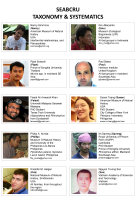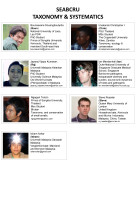Facilitators: Nancy Simmons (American Museum of Natural History), Ibnu Maryanto (Indonesian Institute of Sciences), Paul Bates (Harrison Institute, UK), Faisal Anwarali Khan (Texas Tech University, UNIMAS (Sarawak)), Pipat Soisook (Prince of Songkla University, Thailand), Susan Tsang (City College of New York).
Workshop participants: The workshop included eight participants from Laos, Cambodia, Malaysia, Vietnam, Philippines and Singapore, with guest presentations from Dr Stephen Rossiter (Queen Mary University of London) on the role of genetic data in taxonomy and systematics, Dr Tigga Kingston on echolocation signals as traits in taxonomic/systematic analyses, and Dr Kris Helgen (Smithsonian Museum) on international collaborations. Check out the Field Guide to participants below:
Workshop objectives
The workshop was organized around presentations and discussions of key topics: good data, taxonomy and acoustics, the link between taxonomy/systematics and conservation, taxonomic problems and priorities.
1. Good Data
Background: Much field work produces good specimens the value of which is compromised by poor data collection and storage. Poor data mean that much of the field work has to be repeated for different studies with the consequent negative impact on bat populations as well as unnecessary waste of time and money.
Aim: To raise the standard in data collection and storage to maximize the potential outputs for each specimen and to facilitate collaboration between researchers from different institutions, countries and regions
Outputs: To provide examples (protocols) of best practice in collecting
- Field data relating to the
- Specimen: capture information, age/sex/reproduction, morphometrics, acoustics, genetics,photography
- Location: co-ordinates, habitat
- Lab/museum data relating to the
- Specimen storage: wet/dry specimens, tissue storage
- Data archiving: field data, photographic archive, acoustic files (long term archiving)
SEABCRU Tax and Sys — Good Data – Pipat Soisook
Good Data Minutes
Blank Field note_PSU
2. The link between taxonomy/systematics and conservation
Background: Many students and researchers working on systematics and taxonomy overlook the critical role that their research may play in future conservation efforts.
Aim: To outline how taxonomic projects may inform conservation decisions
Outputs: To provide practical information on how researchers can provide data in a way that will maximize its impact on conservation at the local level, national level, CITES, other.
SEABCRU Tax and Sys — Taxonomy and Conservation – Susan Tsang
3. Taxonomy and acoustics
Background: Acoustic data are providing a useful additional character to identify potential cryptic species. However, much acoustic data in the past have been poorly collected with only limited understanding of the importance of linking individual calls to individual voucher specimens with good geographical data.
Aim: To put the science into ‘acoustic research’ by looking at best practices in gathering and analyzing acoustic data in relation to bat taxonomy.
Outputs: To provide practical information on: choice of recorder (what is the minimum requirement?); how to collect good data; analysis – what are the problems (Myotis, Murininae, Kerivoulinae etc) – is there a solution?; how and when can acoustic data be used to delimit species; future collaboration – regional database? (equivalent of GenBank).
SEABCRU Tax and Sys — Echolocation as a trait – Tigga Kingston
Taxonomy and Acoustics Minutes
3. Taxonomic problems and priorities
Background: In many of the universities in SE Asia there is a throughput of MSc and PhD students looking for good topics to study. It would be very valuable to identify the ‘black holes’ in SE Asian bat taxonomy in order to make the best use of the enthusiasm and skills of these young taxonomists. It is also an opportunity to think regionally rather than nationally and thereby promote a new generation of taxonomists for whom international collaboration and networking is the norm rather than the exception.
Aim: To determine taxonomic research priorities
Outputs: To provide a list of potential topics based on: what makes a good problem?; taxonomic groups – i.e. particular species groups or genera; topics – phylogeography, phylogeny; geographical areas – islands, mountain ranges; conservation priorities – picking projects that will make a difference.
Taxonomic Problems and Priorities Minutes
4. International collaboration – opportunities and impediments
Background: Taxonomists need to collaborate since most species have widespread geographical distributions and much existing data (specimens and literature) are at institutions scattered worldwide. However, there are many practical difficulties associated with the export of specimens and tissue, loans, and conducting field work in another country.
Aim: To determine a viable strategy to overcome some of the worst impediments to collaborative taxonomic research
Outputs: To provide practical information on: current restrictions on the import/export of specimens (including tissue); opportunities for study visits to institutions within SE Asia and internationally; relevant collections held in institutions in SE Asia and internationally – providing contact information and an insight into the scope of their collections; possibilities for joint field studies
SEABCRU Tax and Sys Workshop 2012 — International Collaboration Opportunities and Impediments_Faisal
International Collaborations Minutes
Museum list (June 2012)
5. The role of genetic data
Background: Even if good data are collected, there is frequently a problem in interpreting what this information means in terms of taxonomy, especially when there is conflicting information – i.e. metric and echolocation data show a clear difference between populations whereas mitochondrial DNA and morphology does not discriminate between them.
Aims: To have a clearer understanding of ‘what is a species’ in terms of recent advances in science and technology, especially genetics, and to provide resources for collaborating on gathering and analyzing genetic data.
Outputs:
- To provide a framework for the interpretation of taxonomic characters in relation to different types of data: morphological data (including morphometrics and discrete characters); acoustic data; genetic data (including mtDNA and nuclear DNA).
- Ongoing projects and resources for getting genetic data from samples — to provide a summary of programs and open source code available for analyzing data (phylogeny, population structure, phylogeography, etc.)
SEABCRU Tax and Sys — Role of Genetics – Steve Rossiter
The Role of Genetic Data Minutes
5. What makes a good publication?
Background: Many students in SE Asia have become accomplished field biologists but following the idea that ‘if it isn’t published, it never happened’, field skill is not sufficient. Taxonomists also need to be able to write up and publish their results in good international journals.
Aim: To list and discuss the essential ingredients of a good taxonomic paper.
Outputs: To provide practical information on: the scope of different sections in a paper (Introduction, Methods, Results, Discussion); how to deal with uncertainty in results when writing a paper; putting together good figures and tables; dealing with the review process; journals that are good outlets for taxonomic papers


